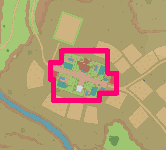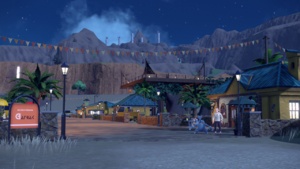From Bulbapedia, the community-driven Pokémon encyclopedia.
Cortondo (Japanese: セルクルタウン Cercle Town) is a town in the Paldea region, located in South Province (Area Two). Olives are the town's biggest export, and as such, it is also home to the Olive Harvest Festival, in which one of the activities involves rolling giant olive-shaped balls into a goal; this is believed to bring in great harvests.
Because of the Gym's specialized type, the people of this town tend to walk around accompanied by Bug-type Pokémon.
Places of interest
Cortondo Gym
- Main article: Cortondo Gym
The Cortondo Gym is the official Gym of Cortondo. The Gym Leader is Katy, who specializes in Bug-type Pokémon.
Glen
A trainer named Glen is located in the center of town. By talking to him, the player is given the option to make an in-game trade. Glen wants a Flabébé, and will trade a Snom named Snowsalot in exchange.
Trivia
- Two Vivillon with the Tundra and Continental patterns can be seen flying over the pool immediately east of Patisserie Soapberry. This is despite the fact that all Spewpa in Paldea will evolve into Vivillon's Fancy Pattern, unless the pattern is changed by sending a Postcard from Pokémon GO (only possible for Version 1.2.0. of Pokémon Scarlet and Violet onwards).
- The tile patterns in the pools are identical to the water tiles from the Generation I map.
Origin
Name origin
| Language
|
Name
|
Origin
|
| Japanese
|
セルクルタウン Cercle Town
|
From セルクル serukuru (round, bottomless mold), ultimately derived from cercle (French for circle)
|
| English
|
Cortondo
|
From cortador de galletas (cookie cutter), redondo (round), and possibly Córdoba and Redondo
|
| German
|
Moldrid
|
From molde (Spanish for mold) and possibly Madrid
|
| Spanish
|
Pueblo Pirotín
|
From pirotín (cupcake liner)
|
| French
|
Sevaro
|
From aro de tarta (Spanish for "cake ring") and possibly Seville
|
| Italian
|
Moldulcia
|
From molde (Spanish for mold), dulce (Spanish for sweets), and possibly Andalucía (Andalusia)
|
| Korean
|
세르클마을 Cercle Maeul
|
Transcription of Japanese name
|
| Chinese (Mandarin)
|
圓模鎮 / 圆模镇 Yuánmó Zhèn
|
From 圓 / 圆 yuán / yùhn (round) and 模 mó / mòuh (mold)
|
| Chinese (Cantonese)
|
圓模鎮 Yùhnmòuh Jan
|






